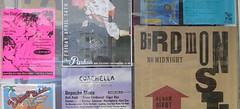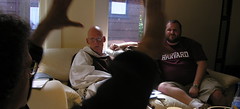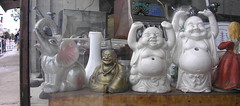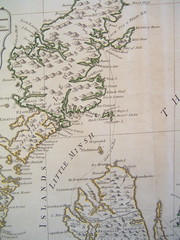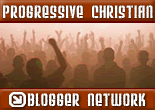The Counterculture That Wasn’t: Fred Turner and the Manufacture of a State Religion for Silicon Valley

Fred Turner’s 2006 book, From Counterculture to Cyberculture, is an important book. For those interested in the information revolutions that led to the present, Turner presents three crucial turning points crucial to the making of contemporary Silicon Valley. The first two are straightforward: a moment of institutionalization in the 1980s, and a moment of corruption in the 1990s around the ideas of deregulation. The third is more difficult.
Some time between 1985 and the present, the internet witnessed the manufacture of a state religion for Silicon Valley. That religion is dominated by a predominantly masculine, educated, jet-set elite, deracinated from their roots; they are unified in an understanding of the telos of history. They have defined and hire for the identifying marks of an initiate in their religion. They have invented, in contradiction to their stated values, a world that rewards men for gift-like exchanges of information but exploits women for the economically unrewarded exchanges of nurture and counseling because of which their world thrives. This is the story of the manufacture of a state religion for Silicon Valley. This story is available to readers of From Counterculture to Cyberculture, but it is more difficult to identify, because it is not the tale that Turner set out to tell.
My students of information revolutions are studying Fred Turner this week in my course at the University of Chicago. I value Turner because he does a good job of setting out the dates since 1985. He tells us about who the economic players were, who created innovations in bureaucratic management, how the politics of Silicon Valley shifted in the 1990s, and what some of the consequences were. All of these events are crucial to understanding the way the internet and the companies that rule it are reshaping the culture of corporations and government’s role with respect to development and information management.
The first of these watersheds was the moment of institutionalization that made Silicon Valley. Turner begins his discussion of these events with the 1985 founding of the WELL, the first online community as the date for the emergence of an ideology based upon dialogue as a social leveler and economic catalyst. The narrative then links the institutionalization of this ideology to the migration of the information industry from MIT to Silicon Valley by the 1980s. Turner’s explanation is that California’s culture of openness lured talent and then capital across the country. The explanation, while insufficient, is provocative. Turner shows too how dialectical ideology became implanted in the very fiber of California-based consulting strategy. He traces the establishment of GBN and the reinstitutionalization of IFTF, both of which wedded the insights of experiment-guided dialogue towards the format of organizational psychology. Northern California institutionalized dialogue as an alternative corporate structure to that of the traditional postwar bureaucracy.
Second, as to the moment of corruption. The 1993 founding of Wired Magazine sets the date for the unholy marriage of dialectical ideology (with its hippie roots) and new-right anti-regulation political policy. The deregulation of media giants like Turner is countenanced by a libertarian-left California alliance that hopes to have already vaccinated the electronic future with an anti-hierarchical open-source movement that will benefit from deregulation. Turner hints at more than he makes explicit, but the implication is clear: the new internet giants like Microsoft and Google were allowed their far-ranging monopolies over communications because the hippie left and libertarian right formed a consensus against regulation. We are now living in that moment of massive deregulation, and it is too early yet to judge the consequences.
These turning points are, I think, correct, and represent useful contributions to the history of twenty-first century society.
Yet the book’s ambitions aim much higher. Turner wants to show, as his title indicates, that the values of the hippie era were transported unblemished into the backbone of the internet. He offers us a set of heroes that he credits with the transformation, LSD-dropping radicals such as Stewart Brand and John Perry Barlow, whose thirty-year trajectories bridged the worlds of Haight-Ashbury and Sand Hill Road. The hero-drive account is seductive, but it becomes problematic when it comes to identifying the political ideas of counterculture and cyberculture, their origins, their influence, and their affects.
. To accredit the 60s with the values of contemporary Silicon Valley, Turner strains to make every connection prove the radical credentials of the internet’s birth. It turns out, according to Turner, that everyone alive between 1954 and 1982 participated in a set of values defined as the counterculture. A similar symptom is defining the openness of the cyberculture inventor in terms, not of their beliefs and actions, but of their milieu. Brand’s adolescent travels around America, for example, are given as evidence of his exposure to the entire diverse milieu of radicality, including abstract impressionism in contemporary New York, SDS, the Free Speech Movement, although no connections have been shown to the actors he names. By this definition, any liberal youth of the baby boom who listened to Bob Dylan while Jackson Pollack was painting next door was necessarily aware that his drug-taking was an opportunity to radicalize perception. This is poor history: to show milieu is not to demonstrate the transmission of ideas. The historian who shows that Napoleon was young during the riots of the French Revolution has shown less than the one who demonstrates the strategies of rule that shaped his formation as a mind. Brand’s strategies for bringing together clever young men around tools have more to do perhaps with the laboratory revolution that hit American university science in the 1920s than with the counterculture. The reader would like to know what strategies Brand and his fellow-entrepreneurs learned from the past. To say that they learned "openness" is to beg the question.
. The celebration of “60s values” by way of history has been around for a while, and it comes with an agenda. Since the moment of the 60s itself, baby-boomer historiography has tended to celebrate all revolutions – Vietnam War Protests, Free Speech, Back-to-the-Landers, and Civil Rights – as a seamless continuum of justice, peace, and love. The agenda is visible in what’s left out. Those who emphasize unity tend not to think very hard about why the 60s failed. They tend not to detect the rift that happened when feminists walked out on SDS; they tend not to inspect how Yippie irony alienated public consensus in favor of the left; they don’t think very hard about the forms of political consensus that had a chance to succeed and why they failed. Baby-boomer historiography, California style, congratulates California for having invented the new age, seeing LSD as the fulfillment of radical politics. Other historians would look to LSD as its betrayal. Baby-boomer historiography, Berkeley style, attributes highest laurels to Mario Savio and the Free Speech Movement. Other historians fault the college-educated counterculture for alienating the poor white families of Vietnam veterans, and so directly abetting the rise of the right. Turner does not show a precise set of countercultural values that definitively influenced cyberculture in its early stages. Instead, he too blurs the events of the 60s, telling us about what happened on the other side of Manhattan while Stewart Brand was young. The blurring is meant to suggest rather than identify the transmission of radical values. Good enough for some, perhaps. But…
. If one cares deeply about mid-century utopianism, one would like to know which revolutions Silicon Valley intended to participate in, and which version of the history of radical ideas it absorbed: a Marxist critique of the origins of capitalist inequality? A Situationist critique of radical culture? A mystical vision of an era of peace lead in by an occult elect, such as the Rosicrucians of Southern California were promoting? We don’t get these nuances out of Turner. We get instead a trite amalgamation of all-things-1960s, a baby-boomer’s nostalgia for multiple movements of peace, love, experimentation, and openness: these, and nothing more specific, will define the roots of cyberculture.
. Another alternative would be telling a longer story about the making of a Californian politics and its role on the internet. The story has to start long before he places it and involve a far broader set of interests than the heroic, peace-loving, Zen-meditating hippies he wants to credit. Take two of the terms key to the founding of the EFF, the Electronic Frontier Federation. Turner convincingly shows that two of the essential terms to the EFF’s self-understanding were the “frontier” and the hive.” Both terms seemingly appear out of nowhere, illustrations of “new communalist” logic spontaneously evolving out of Brand’s fertile skull. Turner thus misses two other points of origin for the terms that are deeply significant in their ideological freight. The role of the frontier in American history was described by Frederick Jackson Turner; the “hive” that would populate the frontier was described by Leary as the next phase in the spontaneous evolution of an Irish-Jewish intellectual elite who would wrest the controls of society from its traditional Anglo-Dutch leaders. These terms appear at the EFF courtesy of SB, thus clouding the possibility that they circulated more widely in a larger group of actors who had a shared conception of what it meant to be Californian and hence a Californian Programmer in the 1970s and 1980s.
. It is worth considering different versions of Cyberculture’s social origins. Long in advance of Silicon Valley, California’s faith in technology was shaped by the ideology of manifest destiny, the westward migration of late-nineteenth-century theosophists, deviant transvestite culture around the turn of the century, women preachers like Annie Semple McPhereson, early twentieth-century migrations, war work, and Pentacostalism. Historians George Pendle and Megan Shaw Prelinger have already given us critical stories about how the California religion found its way into the culture of Boeing and NASA. By 1968, these forces had already set firmly in place the millennial hopes for a technology-based social revolution, long in advance of hippie culture. The hippie contributions to Cyberculture were neither the first to proclaim openness, the first to embrace millennial destiny, nor the first to proclaim the transcendence of gender, class, and hierarchy.
Telling the history in vague terms means getting away with vague definitions of “counterculture values.” Turner’s argument concludes that “experimentation” and “openness” were invented by the counterculture and adopted by cyberculture, and it relies on fuzzy definitions of both terms.
. “Experimentation” and “openness” turn out to be marvelously flexible categories. Turner relies throughout the book on small gestures to stand in for full-out intellectual and political revolution in the history of ideas. He instead gestures towards LSD and Timothy Leary, a season studying radical theologian Tielhard de Chardin. Turner extrapolates a brief exposure into a lifetime of study. The book is not a history of ideas, however, and it remains content to define “openness” in terms of novelty – any type of performance new in the 1960s is defined as open; openness need not be defined in terms of inclusion, social justice, or class or gender identities. Openness in cyberculture is not a form of politics. Ill-defined ideas about novelty are offered as illustrations of the heroes’ sense of adventure.
. A blurry definition of "openness" absolves Turner from pressing a gender or class critique too far. Pressing would reveal the fissures between stated values and social practice. Take the “gift economy” Turner finds at work in the early WELL; the result, he concludes, of countercultural immersion in ideas about tribal belonging and “openness.” Turner gives evidence that the kind of knowledge that would be traditionally coded as feminine – listening, counseling, and giving romantic advice – was freely given, largely by women, free of charge, in vast quantities, without compensation in a form that could benefit one’s career. By contrast, knowledge coded masculine – information about stocks, future technology, and code – was freely exchanged, largely it seems by men, and led directly to the spiraling financial success of reviewer/consultant/journalists such as Howard Rheingold. In other words, the WELL community structurally reduplicated the division between freely-given, non-compensated female labor and freely-exchanged but actively-compensated male labor that formed the most reprehensible characteristic of American postwar suburban housewifery. Turner gives the evidence, but doesn’t perform the analysis. He cites the later career burnout by Ellen Ullman, one of the women who participated in the WELL, without indicating the extent to which gender difference seems to have structured the split between male success post-WELL and female burnout.
The ideas are manhandled this way in the service of his larger mission, a heroic portrait of Stewart Brand, John Perry Barlow, and Esther Dyson as the architects of a more just world. It manhandles ideas in ways deeply flattering to Silicon Valley.
. The result of all this muddling is history in the vein of hero-worship. Turner concentrates the bulk of his research on the biographies of a few saintly counter-cultural digerati -- Stewart Brand, Kevin Kelly, and John Perry Barlow -- as metonymy for the whole. They become impossible geniuses, launching initiative after initiative; idea after idea, if only because Turner starkly refuses to do the research on where these ideas came from or how widely held they were. This is not history; it is biography written in the key of modern lives of saints, like those nineteenth-century idolizing tributes to Napoleon as the advocate of all liberties that tried to tie all the best idylls of the French Revolution and all the rights of man to the general’s experiences in adolescence.
. Such histories tend to miss what is so interesting about the period (a larger movement among a particular set of actors who didn’t exist before, and who are much larger than the individual). History by way of biography tends also to miss what is so interesting about the individual (a leader, wrote John Steinbeck, is the one who happens to be at the head of a crowd when there is a movement happening).
. In fact, staged against the long genesis of California culture, the characters described by Turner look downright backwards. Turner’s evidence points everywhere to the early internet as a gentlemen’s club for bearded hackers, many of whom thought women should stay at home. Once enthusiasm is peeled away, what Turner describes is the coming of an international jet-set elite, removed from the concerns of social justice that typified the 1960s. He writes of two of his heroes, characters he advertises as riding Air Force Two between nations, feted at Davos and the World Economic Forum: “Barlow and Dyson had become packets of information, shuttling from boardroom to conference to media outlet. Their sense of place had become dislocated and their sense of home, like the notion of home on the Net, distributed.” It doesn’t take much interpolation to conclude that Turner is describing the evolution and deracination of a new elite. The new version of the Elks Lodge and Harvard Club, in other words, was the WELL, where one could go expecting rational conversation and sympathy with others of similar background, status, and economic interest. Turner explains that Cyberculture changed everything, but the evidence he gives portrays a nineteenth-century politics of equality for the already privileged, transported unblemished to twenty-first-century California.
Turner indeed proves that contemporary Silicon Valley believes in the lineage he’d like to give – the best of hippie culture, the back-to-the-earth, peace-and-love, radicalism determined to succeed. He conclusively shows that as early as the 1980s, hacker culture in California thought of itself that way: the direct heirs to the movement.
I began by talking about the book’s contributions to a history of information revolutions: the migration of information technology to Silicon Valley, the solidification of dialogue-based corporate practices in Silicon-Valley businesses, and the alliance between the northern California left and the libertarian right around the deregulation of communications. I’d like to conclude by suggesting that the book’s greatest contribution is to highlight one more watershed in twentieth-century information revolutions. But this is a watershed that Fred Turner did not intend to describe: the recent revolution that consisted in manufacturing a state religion for California.
There was a moment when Silicon-Valley intellectuals began to brand themselves with the mantel of the counterculture. Barlow and Brand’s memories, Esther Dyson’s identity as a child of NASA and California, Joi Ito’s adoption by Timothy Leary – all of these factor in, of course. But there was a moment when those secret links were made explicit.
A more complete history of Silicon Valley values would have included a section Turner leaves out: a chapter on a canonization of the hippie founders of Silicon Valley, a moment that deserves its place in American History alongside the Founding of the Daughters of the American Revolution and the 1990s debate over the religion of the Founding Fathers as a moment when artificial history served to implant a new consciousness and manufacture a new political identity of enormous significance for future politics. Like them, the newest articulation of the state religion of California holds the conviction that California invented liberty, and that its forms of spirituality, technology, and politics are inherently purer, less corrupt and less hierarchical than those experienced elsewhere in America.
The canonization of Silicon Valley started perhaps with the smiley-face-adorned cover of Wired magazine in July 1997, which proclaimed “25 years of freedom, prosperity, and a better environment.” Not a big claim: the stress was on the Pax Americana, not the 25-year memory of the failed counterculture reincarnate. They played it down. Subsequent Wired articles became more daring. Canonizaton progressed with the ritual identification of Silicon Valley corporate elites with Burning Man in the 2000s. When, in 2001, Google named, as a the significant credential for hiring VP Eric Schmidt, his participation at the Burn, they canonized that relationship further, adding corporate weight to civic ritual. The manufacture of religion culminated with the publication of Fred Turner’s hagiography of hippie digerati, From Counterculture to Cyberculture, in 2006.
That history, I have tried to suggest, is more myth than fact. Even as a descriptor of present-day Silicon Valley, it falls flat. Take the Gift Economy as institutionalized for Silicon Valley by Burning Man, perhaps the most fleshed-out version of the world Turner describes. In practice, the $300 door pass plus week's supply of food and water plus transport translate into a $1000-a-year fee for participation. The Gift Economy is itself an elite club, a white-male-aristocracy. While it preaches listening, in practice it has but infrequently made concerted political efforts to reach into the ethnic ghettos, trades, and classrooms that radical bridge-building would benefit the most. Burning Man, as the yearly festival of Gift Economy, seems to celebrate a revolution already accomplished. Silicon Valley and the Hippie Old Guard come together as if they had always been one, behaving as if their message of love and justice were already realized.
Artificial histories help to plant identities. But they also work by smoothing over difference. Missing from the Wired history, the civic rituals of Burning Man, or the telling of Counterculture, is the role of dissent, that ingredient that seemed so crucial to the revolutions of 1968. Someone needs to prod these people into taking their own ideals seriously. If they actually care about a gift economy that will conquer the inequalities of gender, class, and race, they need to design an electronic economy that will reflect those values. They need a serious investigation of how, when, and why the gender equality in computer science departments in the 1980s devolved into the male bias we see today. They need to send OLPC’s to Chicago’s southside schools. They need, in terms of ideology, a critical investigation of gifting that takes seriously the possibility of giving to those from whom one can expect nothing.
I mean, God bless’em, I hope the hippie message stays strong, and I’m saving my dollars for a Burning Man ticket this summer like everyone else. All I’m saying is that Fred Turner isn’t, as it turns out, Elijah. Neither was Stewart Brand, marvelous travels though he had.
I just hope that Silicon Valley has some prophets to call out the failures as well as the successes. I’d like to read a history of those prophets some day.



